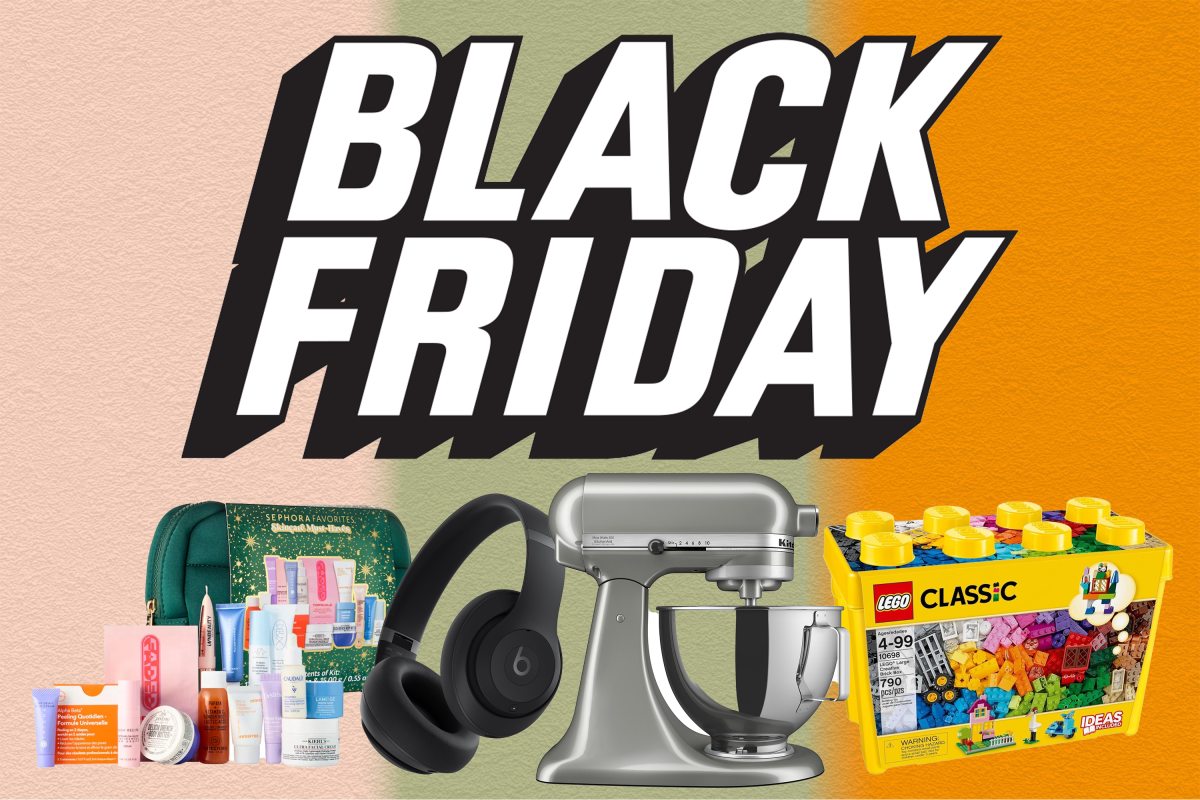Copyright New York Post

Black Friday 2025 isn’t just a shopping event — in our world, and the lives of pretty much every other American, it’s practically a competitive sport. Picture this: a virtual colosseum where deal-hungry gladiators refresh Amazon carts with twitchy fingers, AI-powered shopping assistants whisper gift suggestions into Gen Z’s earbuds and the familiar buzz of “only 3 left in stock” triggers a primal adrenaline rush. In a year marked by overt economic anxiety and tighter budgets, Black Friday sales and Cyber Monday deals are expected to become even more aggressive —and more unpredictable — than ever. Retailers like Walmart, Best Buy, Target and lululemon are already in a high-stakes game of early discounting, vying for attention from shoppers whose wallets are thinner and patience shorter. “As we’ve seen shoppers shift to starting their shopping earlier, retailers have shifted to meet consumer timelines,” Ally Anderson, senior director of insights and strategy at LTK, exclusively shared with Post Wanted. “While Black Friday and Cyber Monday continue to be major shopping events for retailers and consumers, the holiday sales period has become much longer.” Rather than being confined to just two days, retailers now start sales earlier and extend them longer. “Just within the past few years, October has now become the kickoff to holiday shopping with all the major retailers offering sales,” she added. This holds true with Amazon’s Prime Big Deal Days that recently took the e-commerce space by storm. When is Black Friday 2025? Mark your calendars: Black Friday 2025 falls on Nov. 28, but blink and you might miss it. That’s because the best Black Friday deals are now racing each other to launch in early November (or even late October). Thanks to inflation-weary consumers and warnings about limited stock, especially for toys and electronics, retailers are scrambling to kick off sales weeks earlier than tradition dictates. The result? Black Friday isn’t a day anymore. It’s a season. And this year, the season has a serious sense of urgency. According to the Salsify 2025 Holiday Pulse Report, the hot gift categories leading the charge are fashion (54%), personal care and beauty (47%) and electronics (42%). Think: lululemon leggings, Sephora skincare and those elusive new gaming consoles. But snagging these gifts might feel like a Black Mirror episode. According to our experts, The Toy Association reports that toy imports dropped over 30% this year due to tariffs, leaving empty shelves in their wake. Meanwhile, 2 in 5 shoppers say they expect gifts to be more expensive this year, and nearly 1 in 3 are bracing to take on debt just to fund holiday shopping. The stakes? Very real. But in a twist worthy of a holiday rom-com plot line, 90% of shoppers also say they plan to self-gift this year. Yes, while shopping for others, we’re grabbing a little something for ourselves: beauty products, cozy loungewear, maybe a new smart speaker. In fact, this year’s Black Friday 2025 trend might just be unapologetic indulgence in the name of “me time.” With more people working from home, skipping travel plans and focusing on tradition over extravagance, home improvement giants like The Home Depot and Lowe’s are also seeing increased traffic from DIY enthusiasts and homebodies looking to create a stylish nest. Still, there’s an unmistakable tension in the air. A Bankrate survey found that 36% of shoppers say inflation is changing the way they approach holiday shopping — and Gen Z, in particular, is feeling the pressure. With a 23% planned cut in their holiday budgets, many are turning to AI to discover affordable (yet aesthetic) gifts, especially in the fashion and entertainment spaces. AI might not solve every financial worry, but it’s becoming the generation’s savvy new Santa’s helper. Psst…Post Wanted is better than your handy user-generated bot, anyway, because we’re real humans who know the best deals and products worth your hard-earned coin. Is Black Friday or Cyber Monday better? It depends on your strategy and your stamina. Black Friday deals are traditionally dominated by door-busters, with retailers like Walmart, Amazon and Target slashing prices on everything from smart TVs to Apple Watches. It’s also when big-box stores roll out in-store exclusives. But in 2025, those lines outside Best Buy may be shorter as more shoppers gravitate toward the click-happy ease of Cyber Monday, where fashion, tech and beauty steals reign supreme. During the five-day sprint (Black Friday, the two-day extended deals weekend, Cyber Monday and yes, Travel Tuesday), you’ll find a smorgasbord of deals. Think: JCPenney offering stacked online coupons, Hulu subscription deals and a flood of flash sales from Kohl’s and Bath & Body Works. In short: Black Friday is big on electronics and appliances; Cyber Monday wins with apparel and beauty. And if you’re debating which is better, why choose? Many retailers blur the line between the two with “Cyber Week” sales that start Friday and extend through the following Wednesday. The smart move? Create a wishlist, track your items early, and set up deal alerts — especially if you’re hunting for this year’s top-trending items like wearables, smart home gadgets and anything from lululemon (they never stay in stock long). Should I start shopping early this year? Absolutely, and we don’t say that lightly. With retailers dropping Black Friday sales earlier and earlier, waiting until the actual weekend could leave you with fewer options and more stress. According to AARP and PwC’s Holiday Outlook for 2025, delays in shipping and supply chain hiccups are still very real. Combined with the toy import drop, this creates a perfect storm of stock-outs, especially for best-sellers. What LEGO set does your niece want? It might be gone by mid-November. “Gen Z will spend less but shop smarter, cutting budgets by more than 20% YoY and turning to resale, up-cycled and lower-priced items that balance self-expression with value,” Ali Furman, PwC U.S. consumer markets industry leader, shared with The Post. “Shopping will happen earlier.” Anderson at LTK echoes this sentiment, noting that there was a 300% increase in searches for “gifts” on LTK at the end of September, “proving people are shopping earlier and gearing up for the October sales period,” she added. Plus, early shoppers tend to save more. As brands like Amazon, Sephora and Target roll out staggered sales, prices can fluctuate wildly from one week to the next. By shopping early, you avoid last-minute markups — and spare yourself the existential crisis of paying full price two days before a 40% off drop. It’s also the best way to avoid going into debt, as budgeting over several paychecks is a lot easier than panic-swiping your card the week before Christmas. So whether you’re a strategic shopper with spreadsheets or a chaotic cart-filler chasing dopamine deals, Black Friday 2025 is shaping up to be a wild ride. Just remember: the early bird gets the smart speaker. The late bird? They’re stuck refreshing a “sold out” page while eating leftover stuffing. How the economy is shifting Black Friday 2025 shopping trends The words “inflation” and “tariffs” have been making plenty of headlines this year, boiling down to an uncertain economy for every demographic. As a result, more consumers are pivoting their shopping strategies to buy smarter — with certain categories on the rise for 2025. Toys and games continue to build on holiday gift lists Additionally, toys and games are set for a healthy season. “Sales for toys increased by 7.3% year over year,” Furman added. “The U.S. toy market grew by 6% in the first half of 2025, with board and card games, as well as building kits, being perennial gift wins.” Gift cards aren’t impersonal this year “Gift cards remain the top choice for more than half of consumers because they preserve budgets while keeping the spirit of giving alive, and ‘buy now, pay later’ continues to rise among younger generations, stretching their dollars further,” Furman explained. Clothing and apparel are on the rise “We’re seeing apparel re-emerge on wish lists,” Furman explained. Search interest backs the rise of sweaters and cardigans, as Pinterest reports a 110% of searches for cable-knit sweaters heading into 2025. Outerwear is no different, according to Furman. “Trench, bomber, barn and quilted styles are surging; Lyst shows a 40% month-over-month growth in searches for plaid trench coats (a proxy for cropped and city trenches), while editors flag bombers, barn jackets and quilted liners as autumn and winter staples.” Denim will never die either, with wide-leg jeans and baggy momentum appearing on the up-and-up list in sales. “Levi’s cited strong demand for wide-leg fits, with online sales growing by 16% and global direct-to-consumer brands also experiencing a 9% growth in the third quarter of 2025,” Furman said. Not to mention, comfy culture is taking over — specifically, athleisure sets. “Performance-leaning layers (like leggings, tops and jogger sets and quarter-zips) track with sport demand,” Furman added. “Running footwear sales increased by 7% in the first quarter of 2025, while sport-lifestyle sneakers generated $31 billion in 2024.” Why Trust Post Wanted by the New York Post



